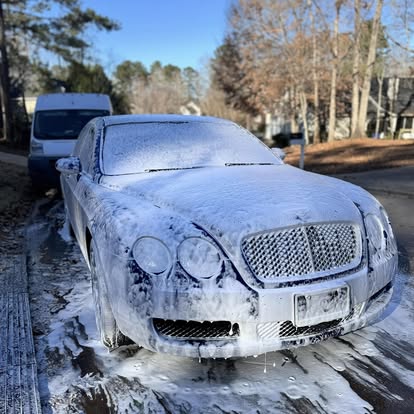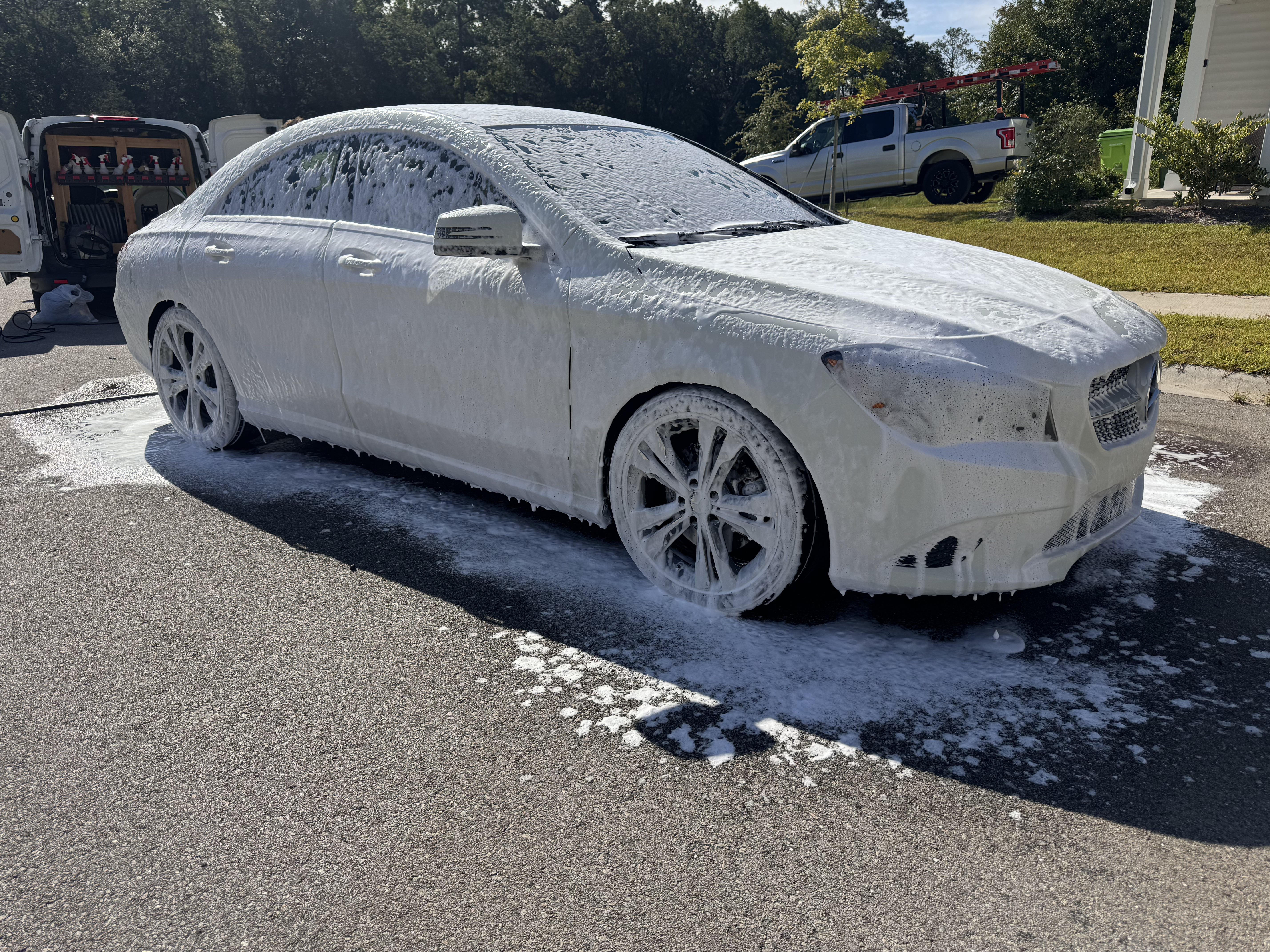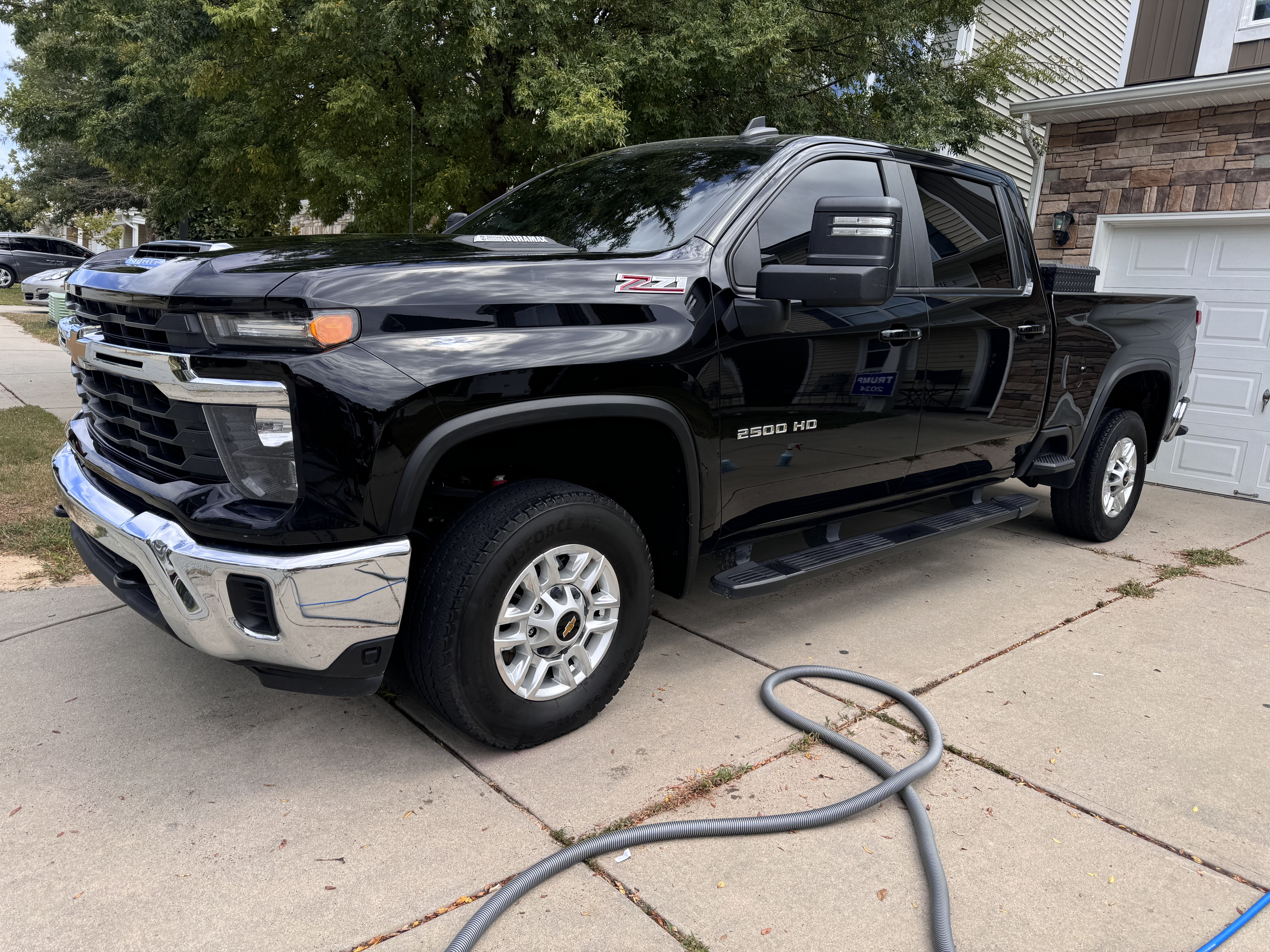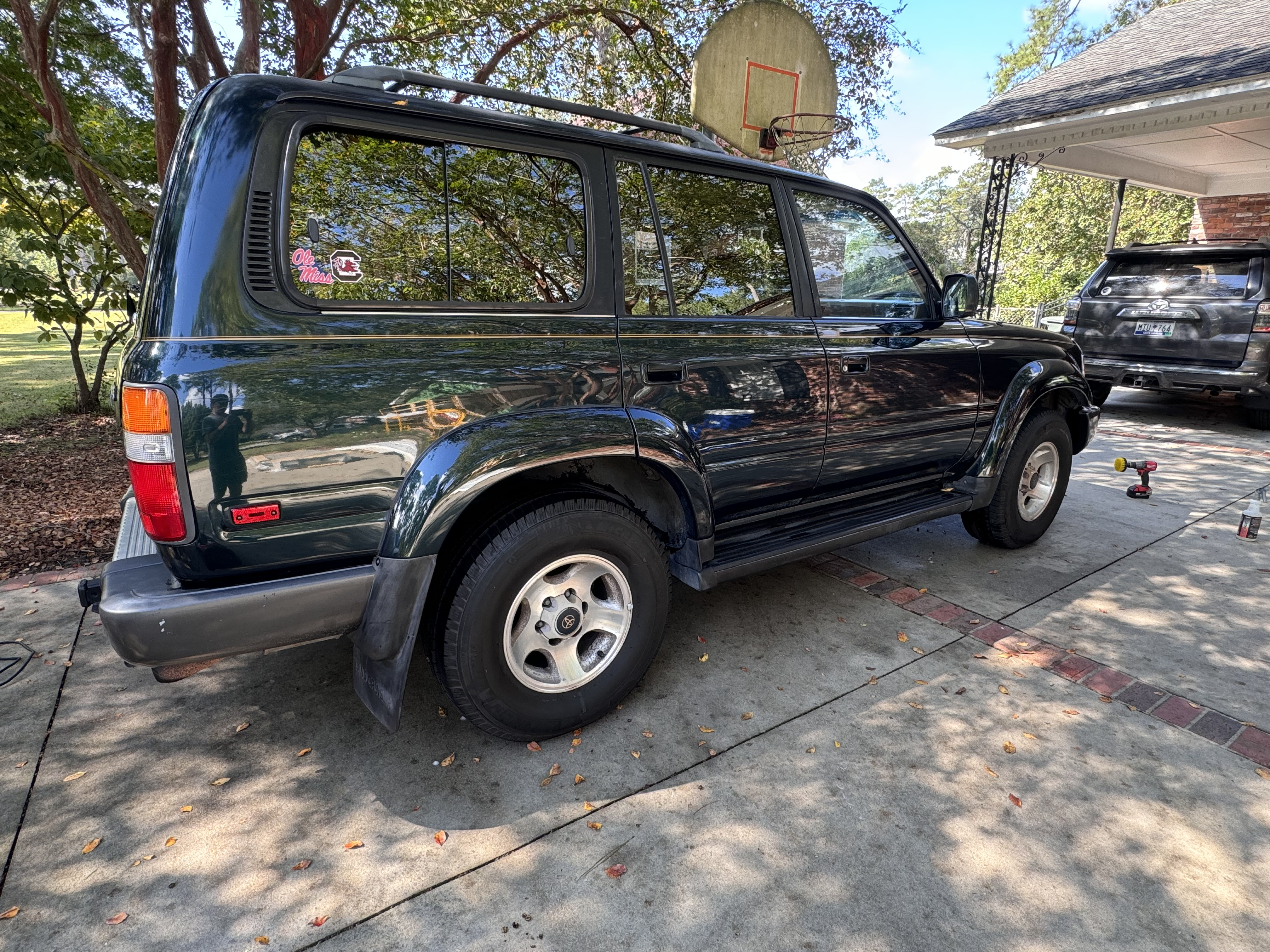The debate between ceramic coating vs wax is especially important for South Carolina vehicle owners. After installing hundreds of ceramic coatings and applying countless wax jobs across Columbia and the Midlands, I've seen firsthand how our climate affects paint protection. South Carolina's intense UV rays, high humidity, seasonal pollen storms, and temperature extremes create unique challenges that make choosing the right protection critical.
Understanding Paint Protection Basics
Your vehicle's paint faces constant assault from environmental hazards. In South Carolina, these threats are amplified—UV index regularly reaches "very high" levels, summer temperatures exceed 95°F, humidity often tops 80%, and spring pollen counts rank among the nation's highest. Without proper protection, paint fades, oxidizes, and degrades rapidly.
Both ceramic coating and wax create protective barriers between your paint and these elements, but they work very differently and offer vastly different performance levels.
What Is Car Wax?
Traditional car wax is typically carnauba-based (from Brazilian palm trees) or synthetic polymer-based. When applied to paint, wax creates a sacrificial barrier that sits on top of your clear coat.
How Wax Works
Wax fills microscopic imperfections in clear coat, creating a smooth, glossy surface. It provides:
- Enhanced shine and depth
- Water beading
- Minor scratch resistance
- UV protection (limited)
- Contaminant barrier
Wax Longevity in South Carolina
In Columbia's climate, quality carnauba wax typically lasts 4-8 weeks. Synthetic sealants extend this to 3-4 months. However, South Carolina's conditions accelerate degradation:
- Heat: Summer temperatures break down wax quickly
- UV rays: Intense sun degrades wax polymers
- Humidity: Moisture penetrates wax layer
- Pollen: Acidic pollen etches through wax protection
- Car washes: Each wash removes protective layer
Most Columbia vehicle owners need to reapply wax every 6-8 weeks during summer, slightly less frequently in winter.
What Is Ceramic Coating?
Ceramic coating (nano-ceramic coating) is a liquid polymer containing silicon dioxide (SiO2) or titanium dioxide (TiO2) that chemically bonds with your vehicle's clear coat. Unlike wax that sits on top, ceramic coating becomes part of your paint's surface.
How Ceramic Coating Works
When applied correctly, ceramic coating undergoes a curing process that creates permanent or semi-permanent bonds with paint. This creates:
- Hydrophobic (water-repelling) surface
- Chemical resistance
- UV protection
- Scratch resistance (not scratch-proof)
- Enhanced gloss and depth
- Easier cleaning
Ceramic Coating Longevity
Professional-grade ceramic coatings last 2-5+ years in South Carolina, depending on quality and maintenance. Premium coatings like CQuartz UK 3.0 or Gtechniq Crystal Serum Ultra can last 5-7 years with proper care.
Ceramic Coating vs Wax: Direct Comparison
Protection Level
Wax: Provides basic protection against UV rays, water spots, and light contaminants. Sacrificial layer means protection diminishes as wax wears away.
Ceramic Coating: Superior protection against UV damage, oxidation, chemical stains, bird droppings, tree sap, and acid rain. Chemical resistance prevents etching from Columbia's acidic pollen and environmental fallout.
Winner for SC climate: Ceramic coating provides significantly better protection against our specific environmental challenges.
Durability and Longevity
Wax: Requires reapplication every 1-3 months in South Carolina. More frequent applications needed for daily-driven vehicles exposed to elements.
Ceramic Coating: Lasts 2-5+ years with basic maintenance. One-time application (with annual maintenance coatings) provides years of protection.
Winner: Ceramic coating offers 10-20x longer protection.
Hydrophobic Properties
Wax: Good water beading when fresh, diminishes quickly. Water contact angle typically 80-90 degrees.
Ceramic Coating: Exceptional hydrophobic properties with 110-120+ degree water contact angles. Water sheets off surface, reducing water spots—crucial for Columbia's hard water.
Winner: Ceramic coating provides superior water repellency that lasts.
Chemical Resistance
Wax: Minimal chemical resistance. Bird droppings, bug splatter, and tree sap can etch through wax layer quickly, especially in heat.
Ceramic Coating: Excellent chemical resistance. Protects paint from etching caused by acidic contaminants. Gives you time to remove bird droppings and bug splatter before damage occurs.
Winner for SC conditions: Ceramic coating's chemical resistance is essential for protecting against pollen, tree sap, and other common Columbia contaminants.
UV Protection
Wax: Provides some UV protection but degrades quickly under South Carolina's intense sun.
Ceramic Coating: Superior UV protection prevents oxidation and color fading for years. Particularly important for black, red, and dark blue vehicles prone to fading.
Winner: Ceramic coating offers significantly better long-term UV defense.
Scratch Resistance
Wax: Minimal scratch resistance. Soft layer provides no meaningful protection against physical damage.
Ceramic Coating: Increased scratch resistance (typically 9H hardness rating). Won't prevent all scratches but resists swirl marks and light scratching from automated car washes and improper washing techniques.
Winner: Ceramic coating offers measurably better scratch resistance.
Ease of Cleaning
Wax: Makes cleaning easier than unprotected paint, but contaminants still bond to surface.
Ceramic Coating: Extremely slick surface prevents contaminants from bonding. Bug splatter, bird droppings, and road grime rinse off easily. Reduces wash time by 30-50%.
Winner: Ceramic coating makes maintenance significantly easier.
Gloss and Appearance
Wax: Excellent warm, wet-looking gloss, especially carnauba wax. Many enthusiasts prefer the "look" of fresh wax.
Ceramic Coating: Deep, reflective gloss that lasts. Enhances paint depth and clarity permanently rather than temporarily.
Winner: Subjective, but ceramic coating maintains showroom appearance longer.
Cost Comparison: Ceramic Coating vs Wax
Wax Costs
DIY wax application: $15-50 per application. Assuming 6 applications per year in South Carolina climate:
- Year 1: $90-300
- 5 years: $450-1,500
- Plus labor: 2-3 hours per application = 30-36 hours over 5 years
Professional wax application in Columbia: $75-150 per application
- Year 1: $450-900
- 5 years: $2,250-4,500
Ceramic Coating Costs
Professional ceramic coating in Columbia, SC:
- Entry-level coating: $600-900 (2-3 year durability)
- Mid-tier coating: $1,200-1,800 (3-5 year durability)
- Premium coating: $1,800-3,000 (5-7 year durability)
- Annual maintenance: $150-300 per year
5-year premium coating cost: $2,550-4,500 (coating + maintenance)
Long-Term Value Analysis
Over 5 years, ceramic coating and professional wax costs are comparable. However, ceramic coating offers:
- Superior protection (better resale value)
- Significantly less time investment
- Better protection for South Carolina's harsh conditions
- Reduced wash frequency and effort
For Columbia vehicle owners planning to keep their car 3+ years, ceramic coating provides better value.
When to Choose Wax
Despite ceramic coating's advantages, wax makes sense in certain situations:
Short-Term Ownership
If you lease or plan to sell within 1-2 years, wax provides adequate protection without significant upfront investment.
Budget Constraints
Quality wax costs $20-50, making it accessible when ceramic coating isn't financially feasible.
Classic or Show Cars
Some collectors prefer traditional carnauba wax for its appearance and the ritual of hand-waxing prized vehicles.
Supplemental Protection
Wax can supplement ceramic coating, adding an extra sacrificial layer during harsh seasons.
When to Choose Ceramic Coating
Ceramic coating is the superior choice for most Columbia vehicle owners:
Long-Term Ownership
Planning to keep your vehicle 3+ years? Ceramic coating pays for itself through protection, reduced maintenance, and preserved resale value.
Daily Drivers in SC Climate
Vehicles exposed to Columbia's sun, humidity, pollen, and temperature extremes benefit immensely from ceramic coating's superior protection.
New or Recently Purchased Vehicles
Protect your investment from day one. Ceramic coating prevents damage rather than repairing it later.
Dark-Colored Vehicles
Black, dark blue, and red vehicles show swirl marks, water spots, and oxidation more readily. Ceramic coating's scratch resistance and UV protection are especially valuable.
Low-Maintenance Preference
If you want maximum protection with minimal ongoing maintenance, ceramic coating is ideal.
The Ceramic Coating Application Process
Professional ceramic coating installation requires expertise and proper preparation:
Step 1: Paint Correction
Ceramic coating amplifies paint condition—it won't hide swirl marks or scratches. We perform [service-paint-correction] to perfect the surface first, removing oxidation, scratches, and imperfections.
Step 2: Decontamination
Clay bar treatment removes bonded contaminants. Paint must be completely clean for coating to bond properly.
Step 3: Panel Wipe
Isopropyl alcohol (IPA) wipe removes all oils, waxes, and residues, ensuring perfect coating adhesion.
Step 4: Coating Application
Applied panel by panel in controlled environment. Proper technique ensures even coverage without high spots.
Step 5: Curing
Coating must cure undisturbed. Some coatings cure in hours, others require 24-48 hours. Infrared curing accelerates this process.
Professional installation takes 1-3 days depending on vehicle size and coating type. This preparation and expertise justify the cost—improper application wastes money and provides poor results.
Maintaining Ceramic Coating vs Wax
Wax Maintenance
- Reapply every 1-3 months in South Carolina
- Use pH-neutral car soap
- Avoid automated car washes that strip wax
- Hand wash preferred
Ceramic Coating Maintenance
- Wash every 2-4 weeks with pH-neutral soap
- Annual maintenance coating recommended
- Avoid abrasive polishes
- Touch-free or hand wash only
- Remove contaminants promptly (bird droppings, bug splatter)
Both require proper washing techniques, but ceramic coating is more forgiving and requires less frequent attention.
Common Misconceptions About Ceramic Coating
Myth: Ceramic Coating Is Scratch-Proof
Reality: Ceramic coating is scratch-resistant, not scratch-proof. It prevents swirl marks and light scratching but won't stop key scratches or major impacts.
Myth: You Never Need to Wash Ceramic-Coated Cars
Reality: Ceramic coating makes washing easier and less frequent, but regular maintenance is still essential for longevity and appearance.
Myth: DIY Ceramic Coating Is as Good as Professional
Reality: Consumer-grade coatings lack the durability and performance of professional products. Proper paint correction and application technique require professional expertise.
Myth: Ceramic Coating Replaces Paint Protection Film (PPF)
Reality: Ceramic coating and PPF serve different purposes. PPF provides physical impact protection; ceramic coating provides chemical and UV protection. They're complementary, not interchangeable.
The Best Choice for South Carolina Vehicles
For Columbia and Lexington vehicle owners, ceramic coating is the superior long-term investment. South Carolina's climate accelerates paint degradation—our intense UV exposure, high humidity, extreme heat, and seasonal pollen storms demand maximum protection.
While wax provides adequate short-term protection at lower cost, ceramic coating's superior durability, protection, and ease of maintenance make it the smart choice for most vehicle owners planning to keep their cars 3+ years.
Consider your specific situation:
- Budget-conscious, short-term ownership: Quality wax or synthetic sealant
- Long-term investment, maximum protection: Professional ceramic coating
- New vehicle or recently corrected paint: Ceramic coating to lock in perfection
- Daily driver in harsh conditions: Ceramic coating for best protection
Whatever you choose, protecting your paint from South Carolina's harsh environment preserves your vehicle's appearance and value. Professional [service-ceramic-coating] from experienced installers ensures you get maximum performance and longevity from your investment.



